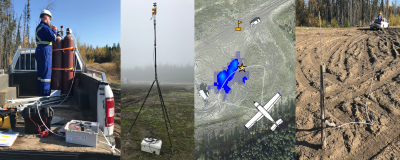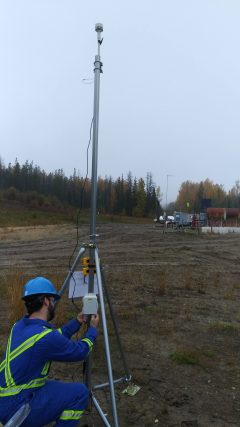
In a new publication appearing in the prestigious journal Remote Sensing of Environment, the Energy & Emissions Research Lab (EERL) has quantitatively and transparently tested a new airborne LiDAR technology developed by Bridger Photonics Inc., which has the potential to transform how oil and gas sector methane sources are detected, quantified, and mitigated. Airborne measurements using Bridger’s Gas Mapping LiDAR™ (GML) technology were performed at active oil and gas facilities in Northern British Columbia, Canada, while a ground team moved beneath the plane deploying and redeploying wind sensors at a subset of sites as part of evaluating measurement uncertainties due to uncertain wind data.  However, unbeknownst to Bridger, the EERL ground crew was also able to perform controlled methane releases at several sites, providing a true, blinded assessment of the sensitivity of the Bridger technology and its ability to find sources without knowing where to look or even that an evaluation was underway. Overall the EERL team was able to catch up with the plane at 48 unique sites completing 65 wind measurements (some sites were visited again by the aircraft on subsequent days) as well as 29 controlled methane releases at 22 distinct sites during the 5-day aerial survey.
However, unbeknownst to Bridger, the EERL ground crew was also able to perform controlled methane releases at several sites, providing a true, blinded assessment of the sensitivity of the Bridger technology and its ability to find sources without knowing where to look or even that an evaluation was underway. Overall the EERL team was able to catch up with the plane at 48 unique sites completing 65 wind measurements (some sites were visited again by the aircraft on subsequent days) as well as 29 controlled methane releases at 22 distinct sites during the 5-day aerial survey.
These data give unique insight into the current real-world performance of the Bridger technology and provide invaluable data for understanding the potential utility of this or similar airborne measurement technology in meeting regulatory requirements and in interpreting field measurement data to develop better inventories and drive mitigation of emissions.
 Results were used to derive a detection sensitivity limit as a function of wind speed and demonstrate that Bridger’s GML technology it is capable of detecting, locating, and quantifying individual sources at or below the magnitudes of recent regulated venting limits. Most importantly, this publication lays the groundwork for upcoming analyses by EERL using airborne survey data to help re-derive methane inventories for oil and gas activity in British Columbia and beyond.
Results were used to derive a detection sensitivity limit as a function of wind speed and demonstrate that Bridger’s GML technology it is capable of detecting, locating, and quantifying individual sources at or below the magnitudes of recent regulated venting limits. Most importantly, this publication lays the groundwork for upcoming analyses by EERL using airborne survey data to help re-derive methane inventories for oil and gas activity in British Columbia and beyond.
Publication
M.R. Johnson, D.R. Tyner, A.J. Szekeres (2021), Blinded evaluation of airborne methane source detection using Bridger Photonics LiDAR, Remote Sensing of Environment, Volume 259, 112418. (doi: 10.1016/j.rse.2021.112418)